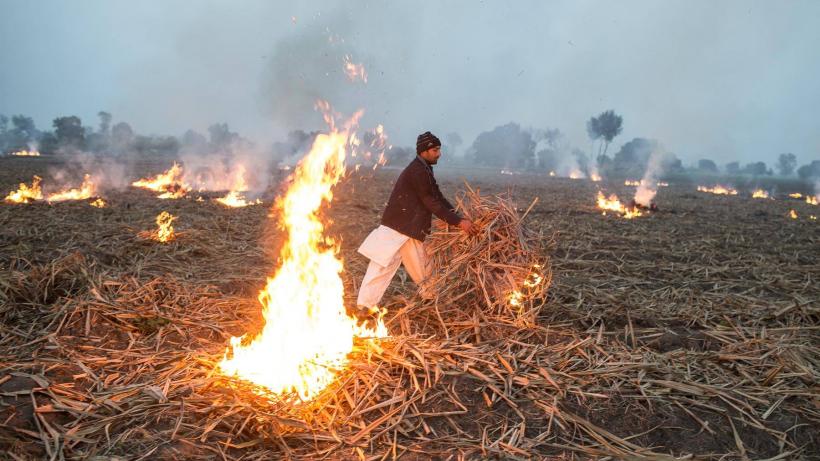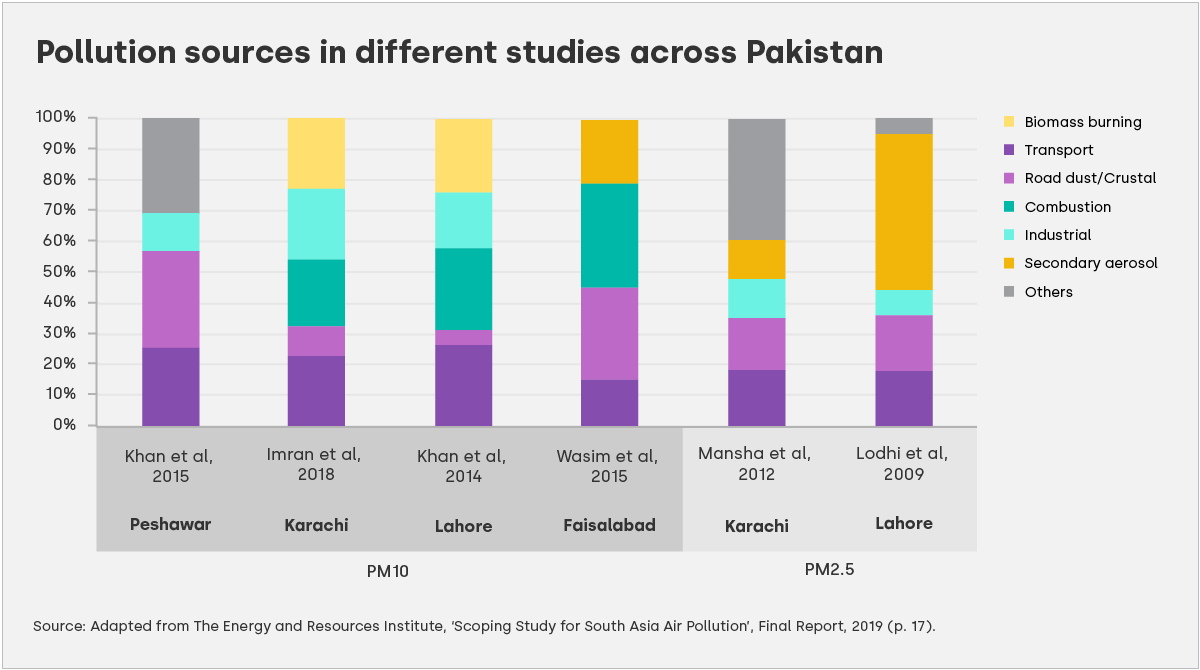
Stubble burning in Pakistan: Why it continues and how can it be curtailed
Many farmers consider stubble burning as the most effective and cost-efficient way to clear land for the next planting season. However, the environmental and health costs of agricultural stubble burning far outweigh the short-term economic benefits for farmers. This necessitates policy actions that offer environmentally friendly and affordable alternatives for farmers.
Despite the risks and safety concerns, burning of crop residue is an extremely common and widely acceptable practice in Pakistan especially in the rice-wheat belt of the country. Agriculture accounts for a fifth of Pakistan’s GDP and is largely concentrated in the Punjab province. Between October and January every year, out of 8.5 million tonnes of rice residue produced, at least 3.6 to 5 million tons is burnt to clear the fields for sowing wheat. Burning stubble remains the fastest and most affordable way to prepare fields for subsequent planting seasons.
Environmental impact of stubble burning
Around this time, Punjab witnesses a significant deterioration in air quality, while Pakistan’s largest urban centres, Lahore and Karachi already rank amongst the most polluted cities of the world. The sharp increase in air pollution is caused by crop burning fires along with thermal inversion - a meteorological phenomenon in which particulate matter and other pollutants trapped in air, mix with condensed water vapour to form smog. This amplifies and prolongs the smog phenomenon in winters. In fact, Pakistan’s only comprehensive source apportionment study by the Food and Agriculture Organisation (FAO) in 2018 attributes 20% of the air pollutant emissions in Pakistan to crop burning.
Figure 2: Pollution sources in different studies across Pakistan

Note: This graph illustrates the underlying sources of smog in Pakistan as identified by geographic information system – R-SMOG (Source).
Air pollution has many direct and indirect costs; it can cause premature death, reduce work productivity and educational attainment, and can be particularly damaging for pregnant mothers and children. All of this is estimated to cost Pakistan up to 6.5% of its annual GDP. An improvement in Pakistan’s air quality on a scale similar to China’s can lead to an increase in average life expectancy of its residents by 1.2 years. Some of the measures by the Chinese included prohibition of coal-fired power plants in the most polluted regions, restricting the number of cars on the road, and introducing all-electric buses. China also shut down many of its coal mines. Crop burning not only contributes to air pollution but over time it also leads to nutrient loss, depletion of soil organic matter, reduction in beneficial soil biota and soil fertility by 25% to 30%, and it also undermines the soil's capacity for water retention.
A consequence of market failure?
The excessive reliance on crop burning stems from a market failure around externalities where the true social cost of crop burning is not recognised and exceeds the private costs incurred by farmers while burning stubble. Globally, crop burning remains the largest contributor to black carbon - formed by the incomplete combustion of fossil fuels, wood and other fuels - which disappears after a few weeks but its impact on global warming is several thousand times more than carbon dioxide (found in vehicular emissions). Information asymmetries lead farmers to think they are cost saving by burning stubble and they are often unaware of the adverse long-term implications on the environment, crop productivity and farming costs. If farmers understood the social costs (cost to the health and environment), they may be more willing to adopt alternative methods of residue management with much lower social costs.
However, many farmers lack the tools, knowledge or resources to adopt more environmental-friendly alternatives which include both in-situ and ex-situ mechanisms. Ex-situ residue management methods include biomass power plants and biofuel projects whereas in-situ management of crop residue is through the use of appropriate equipment such as Happy Seeders (discussed below). Often farmers are not fully aware of the alternatives and its harmful effects. Evidence shows farmers aware of negative effects of crop burning are less likely to burn residue. Farmers also lack knowledge about how crop residues can be incorporated back into the soil and the kind nutrients needed for the crops. However, any awareness raising campaign should be run parallel to implementing practical solutions that empower farmers both technically and economically.
The current policy approaches
In 2019, the Government of Punjab introduced a ban on crop burning for one month starting in October each year. The district government, with support from the Agriculture Department can fine up to PKR 50,000 (US$ 300) per acre if a farmer is caught burning stubble. However, enforcement and compliance remain weak especially in the absence of feasible alternatives and agricultural fires continue to occur. Farmers do not find the fine prohibitive, and without access to affordable alternatives, crop burning is likely to persist. Penalising farmers in this situation is not politically viable either and these bans can only be effective if alternatives and information about them is available and accessible.
In 2020, the Punjab Agriculture Department launched a programme to subsidise a bundle of equipment, Rice Straw Shredders and Happy Seeders. They make the rice stubble more manageable and then incorporate it back into the soil, eliminating the need to burn. In 2021, the government decided to pay 80% of the costs (around US$ 2100) to 500 farmers out of 2300 selected through a lottery system. The Happy Seeder equipment can potentially reduce greenhouse gas emissions by 78% per hectare.
Leveraging this random assignment of machinery, a group of researchers based at the IGC1 are planning to evaluate the hypothesised impacts. They will in particular assess whether in the short term, subsidising green technology reduces pollution by shifting farmers away from crop burning. Their on-going study also intends to measure impacts of the technology itself while also investigating factors that influence uptake in the context of heavy government subsidies. Complete residue removal is around 34% costlier for farmers than complete burning and costs approximately US$ 55. The average subsidy required to incentivise farmers to move towards alternatives is anywhere between US$ 11 and US$ 30 per acre. Incidentally, this was the amount that Punjab and Haryana states had planned to pay farmers in 2019. Thus for an approximate 4.6 million acres, it would cost between US$ 50 to US$ 138 million per year.
Exploring other options?
Payments for ecosystem services (PES)
One policy option for reducing stubble burning can be providing payments for ecosystem services (PES), made to farmers who agree to manage land/activities by adopting environmentally and ecologically friendly practices. Such a system can potentially be executed through a conditional cash transfer (CCT) programme via Pakistan’s umbrella social protection platform Ehsaas with support from the Department of Agriculture. Ehsaas manages Pakistan’s flagship and one of South Asia’s largest cash transfer programmes called the Benazir Income Support Programme (BISP).
CCTs have often been used to restore efficiency where externalities exist and/or improve equity by targeting the poor. CCTs that offer PES to reduce crop burning have shown success in India. CCTs can also make alternatives more economically viable and incentivise their adoption by farmers.
The government can use existing infrastructure to roll out this programme. It has in place a Kissan (farmer) card through which eligible farmers can register for and avail such payments digitally. Applications can be verified by local staff and targeting can rely on the socio-economic registry maintained by BISP and the database at the department. Some payment can be made upfront to help build trust and give farmers a financial cushion to purchase/rent Happy Seeders or other equipment. Farmers could then call relevant teams to check compliance before sowing wheat and receive the remaining amount. Overall payments should be large enough to cover the cost of stubble removal.
Boosting demand for bioenergy
About 25% to 40% of any crop has value as food while the rest which is often wasted can be a low-cost source of raw material for bioenergy. However, commercial markets for biomass-energy in Pakistan are not well developed. The total rice and wheat potential available for energy generation in Pakistan is more than 600,000 terajoules with an annual production of approximately 40 million tons. Government intervention can activate these markets and provide farmers an alternative use for crop residue and an opportunity to earn additional income by selling residue. This can also encourage the production of renewable/alternative energy.
For this, the government needs to establish a practical business model and a bio-waste supply chain system that connects farmers to these markets. Government could also setup storage facilities for crop residue in areas with a high incidence of crop burning or rice production. It would also be important to take steps to boost demand for bioenergy that would encourage private sector participation in supply chain operations. This could include estimates of how much residue could potentially be used up, and accordingly create markets for briquettes made from crop-residue; introducing policies mandating neighbouring thermal power plants to co-fire crop residue with coal; initiating minimum usage ratios of crop residue biomass in industrial boilers and biomass electricity generation projects (the Central Electricity Authority of India (CEA) recommends a blend of 5 to 10 % of biomass). In return, farmers can receive compensation through direct deposits into their banks or through their Kissan cards.
To change the well-established habit of crop burning, a lot of effort will be required to provide education, raise awareness, and build capacity of farmers. While it may be a tall order, its impact can be considerable and far-reaching towards a more sustainable future.
Editor's note: This article is part of our climate change series exploring the challenges and opportunities of promoting a low-carbon, sustainable future in developing countries.

